Dell U3818DW Curved Monitor Review
Why you can trust Tom's Hardware
Grayscale, Gamma & Color
Grayscale Tracking
The U3818DW can be used in its Standard color mode without adjustment. It meets the calibration numbers printed on the included data sheet and is accurate enough for most critical tasks. To maximize performance, choose the Custom Color mode and tweak the grayscale as we did.
Our grayscale and gamma tests are described in detail here.
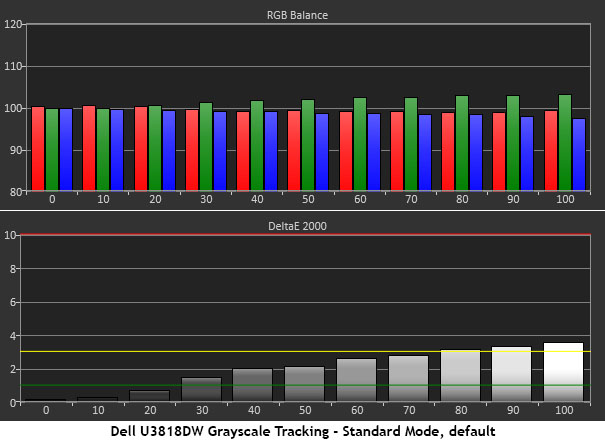
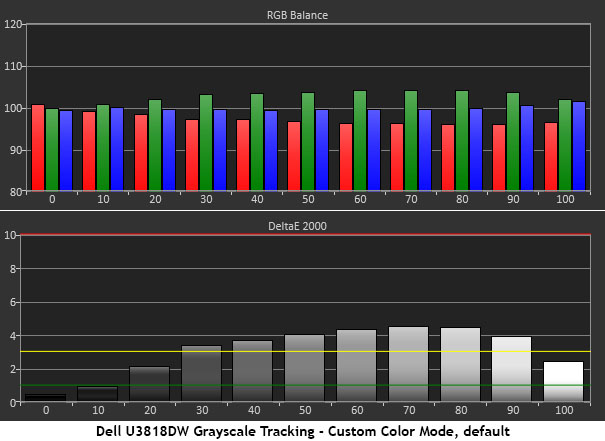
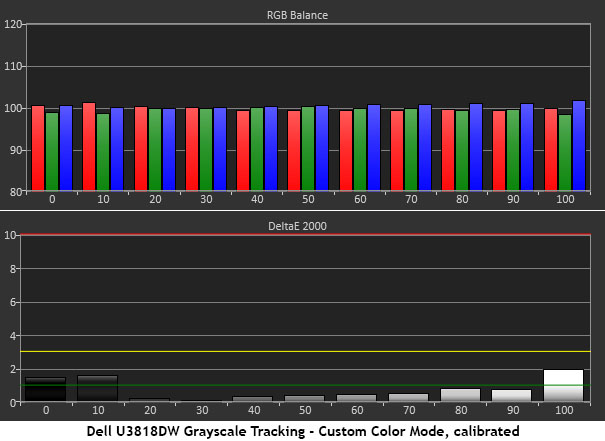
Grayscale errors in Standard run ever-so-slightly green at the 80-100% levels. If we hadn’t told you about it, you’d likely not see it. The U3818DW easily qualifies for our “doesn’t need calibration” list.
If you wish to tweak the Custom Color mode, you’re committed to adjusting the RGB gains, because green errors are more visible. The average Delta E jumps to 3.41; not too high, but enough to be seen. The sliders are extremely precise, and after lowering the contrast control, we got all errors under 2dE. This is excellent performance and we think it’s worth making the changes despite a loss of dynamic range.
Comparisons
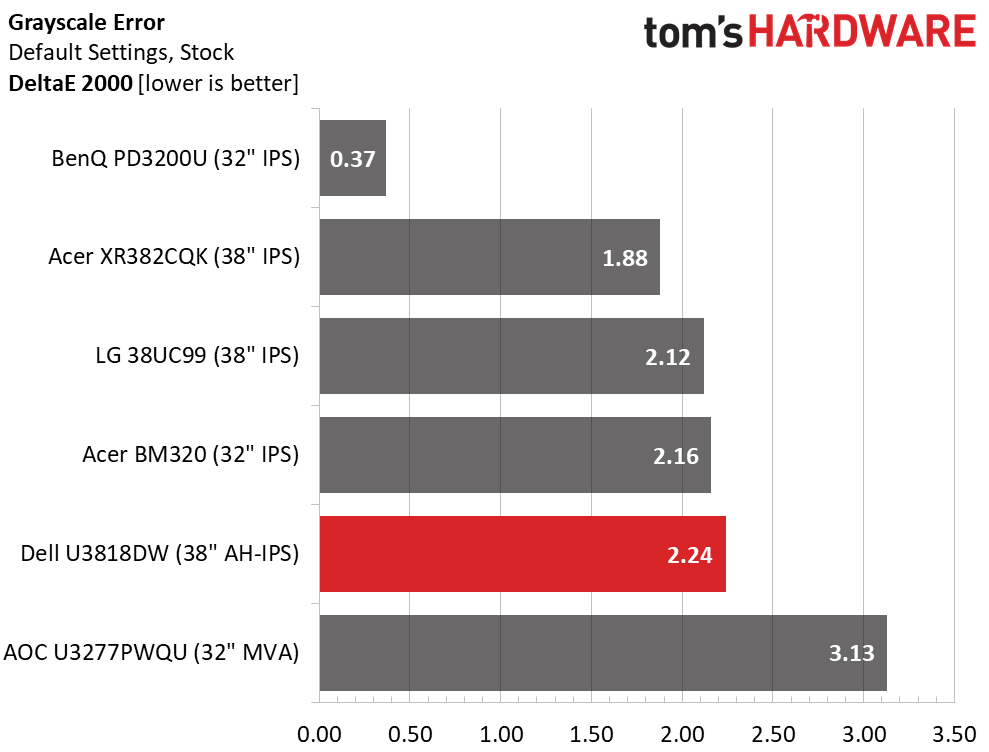
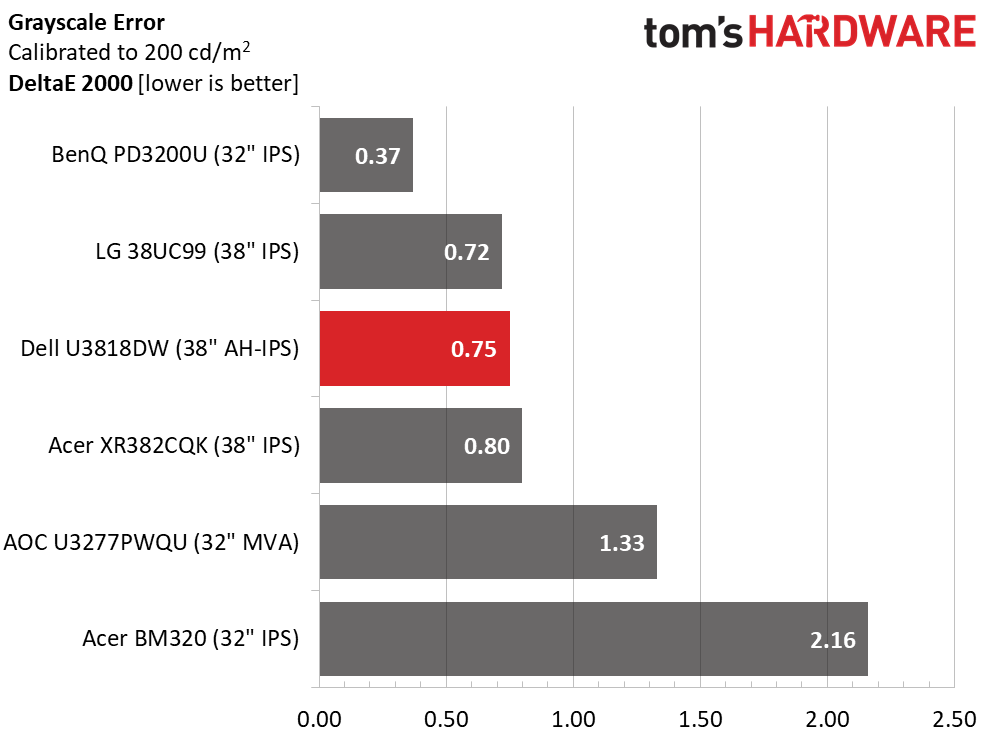
2.34dE for the Standard mode puts the U3818DW in step with the other displays here except for BenQ, which has amazing out-of-box accuracy. That’s why the PD3200U has become our reference monitor. None of the panels here need calibration, but given their intended use, it wouldn’t make sense to ignore that last tiny bit of performance.
Calibration brings the U3818DW to the professional level with a .75dE average grayscale error. It doesn’t get much better, and at this point the difference between all the monitors is negligible except for the BM320, which is unchanged from its default state.
Gamma Response

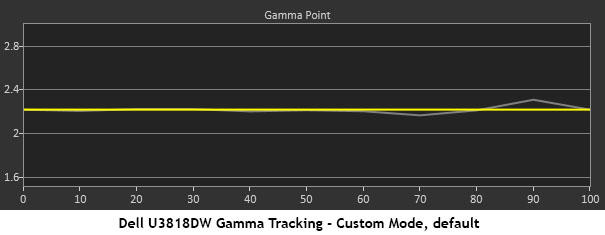
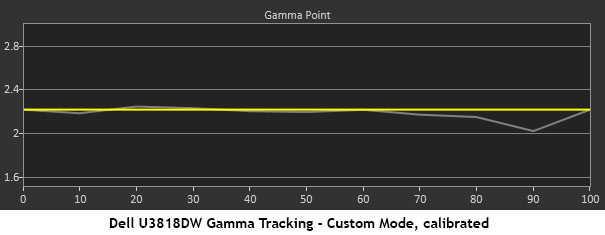
The U3818DW’s gamma is nearly spot-on regardless of mode or adjustment. In Standard, there’s only a small aberration at 10%, which is a little too bright. This helps bring out shadow detail, but it also reduces perceived contrast. Switching to Custom smooths out the trace and after tweaking the RGB sliders only shows a slight dip at 90%. Overall contrast is lower than average, but solid gamma like this helps improve color and overall image quality.
Get Tom's Hardware's best news and in-depth reviews, straight to your inbox.
Comparisons
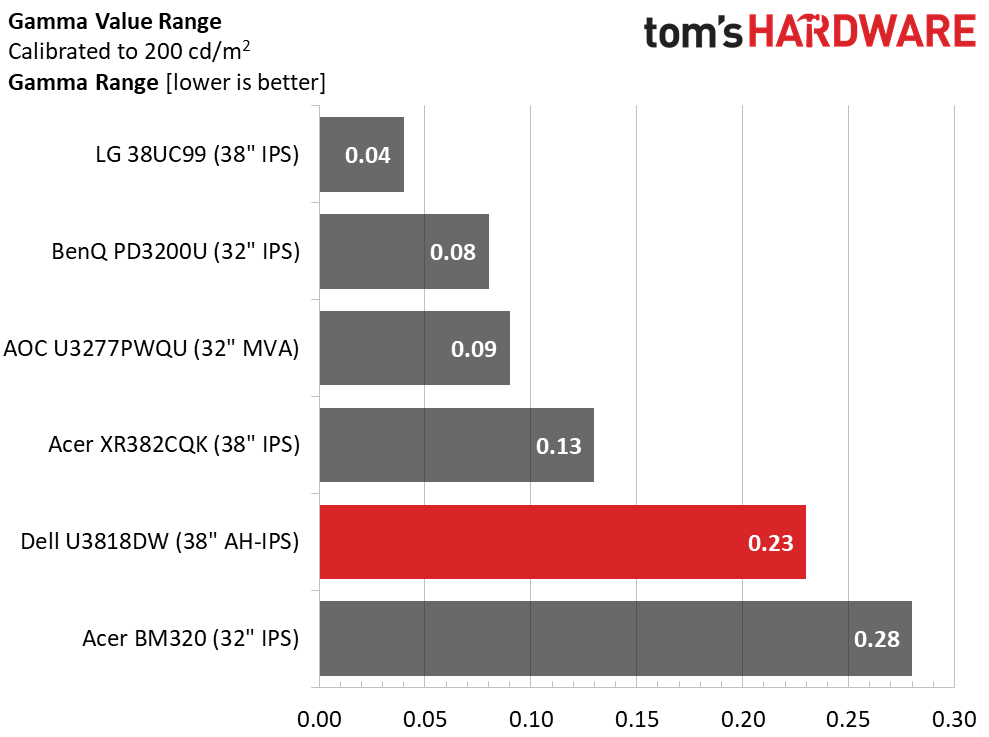

Aside from the AOC monitor, gamma performance is pretty much the same from all screens in the group. LG posts the best numbers with an extremely small range of values and a tiny 1.36% deviation from 2.2. The U3818DW is only slightly behind with a .23 value range and 1.81% deviation, which represents an average of 2.16.
Color Gamut & Luminance
The U3818DW has hue and saturation controls for all six colors, but we didn’t need to touch them thanks to excellent out-of-box accuracy and a native gamut that nails the sRGB standard.
For details on our color gamut testing and volume calculations, please click here.
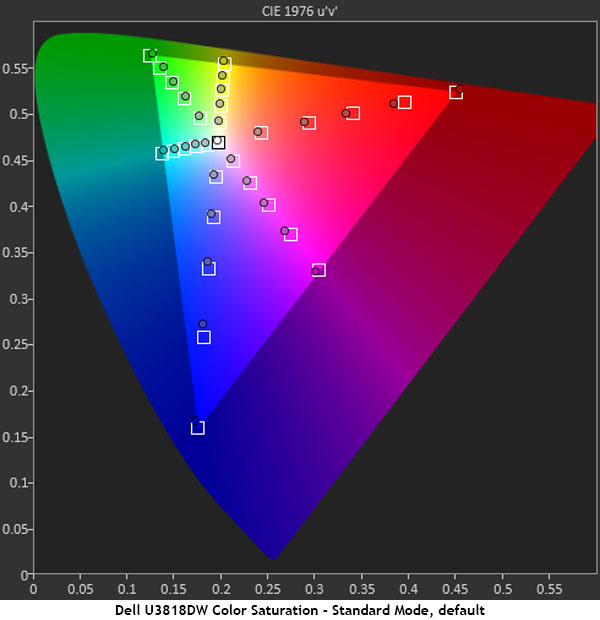


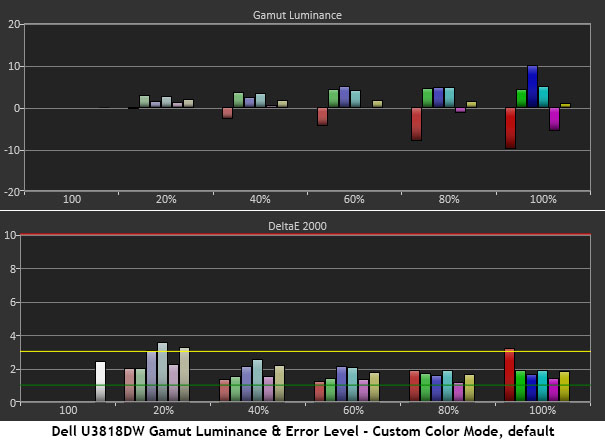


On the above CIE charts, any measurement point that at least touches the target square is within 3dE of perfect. As you can see, the Standard mode has no visible errors whatsoever. Luminance levels are nearly all neutral as well.
Custom Color introduces a slight hue error in magenta, but again, it’s not at the visible level. Calibration easily brings that secondary back in line for a final result that’s as good as any professional display we’ve tested. Not only is the native gamut where it should be, accurate gamma means correct saturation and neutral luminance levels throughout the color triangle.
Comparisons

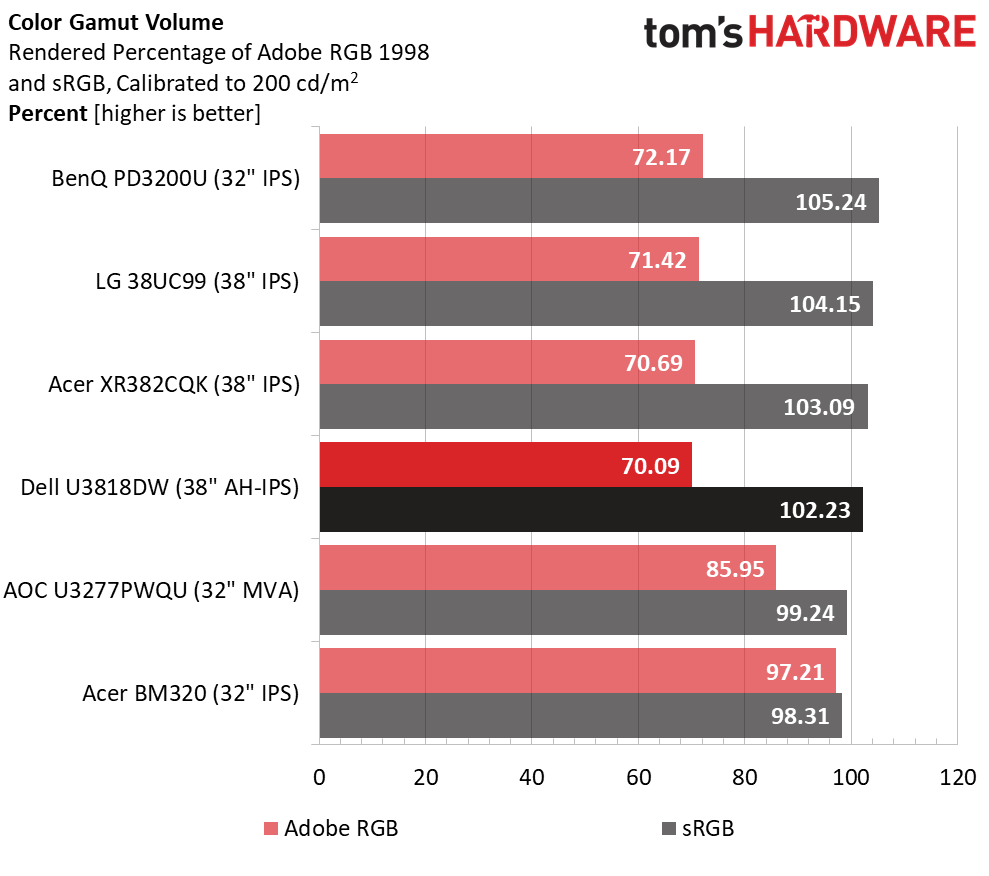
The U3818DW is slightly ahead of its 38” cousins in the color accuracy department thanks to the LG and Acer screens’ over-saturated gamuts. The difference is only visible to our i1 Pro meter, but when deciding between displays at this price point, every detail counts. You can see the bonus color in the volume chart where Dell comes closer to a true 100% sRGB gamut than the top three monitors. With a little bonus red in the mix, we suggest a custom profile when committing any of these products to color-critical work.
MORE: Best Gaming Monitors
MORE: Best Professional Monitors
MORE: How We Test Monitors
MORE: How To Choose A Monitor
MORE: All Monitor Content
Current page: Grayscale, Gamma & Color
Prev Page Brightness & Contrast Next Page Viewing Angles, Uniformity, Response & Lag
Christian Eberle is a Contributing Editor for Tom's Hardware US. He's a veteran reviewer of A/V equipment, specializing in monitors. Christian began his obsession with tech when he built his first PC in 1991, a 286 running DOS 3.0 at a blazing 12MHz. In 2006, he undertook training from the Imaging Science Foundation in video calibration and testing and thus started a passion for precise imaging that persists to this day. He is also a professional musician with a degree from the New England Conservatory as a classical bassoonist which he used to good effect as a performer with the West Point Army Band from 1987 to 2013. He enjoys watching movies and listening to high-end audio in his custom-built home theater and can be seen riding trails near his home on a race-ready ICE VTX recumbent trike. Christian enjoys the endless summer in Florida where he lives with his wife and Chihuahua and plays with orchestras around the state.
-
Realist9 I guess I give up on waiting for a 4k, 32" or greater G-sync monitor at >60hz.Reply
Even though the 1080 has been out 1.5 yrs and can handle it, the market must just be too small for manufacturers to make them. Bummer. -
photonboy REALIST9,Reply
4K, 144Hz, GSYNC is coming in 2018...
https://wccftech.com/g-sync-hdr-monitors-available-q2-2017/
Break open your piggy bank though... -
Lucky_SLS How does a curved screen benefit professional work? I thought it was just for the immersion. And this is 2300R instead of 1800R.Reply -
Tanquen 37.5” = Yea!Reply
IPS = Yea!
10-bit color = Yea!
3840x1600-pixel resolution – Yea!
USB 3.1 Type C = Yea!
HDMI 2.0 = Still no 2.1?
21:9 = Lame!
Curved = Why?! Why do folks want their screen squished in the middle and the ISO graphics distorted?
No FreeSync = God Dam it! -
Tanquen Reply20417912 said:How does a curved screen benefit professional work? I thought it was just for the immersion. And this is 2300R instead of 1800R.
It doesn’t. It’s a gimmick that they think will help sell displays. This has mostly come and gone from the TV space but the computer monitors always seem to be a year or more behind. -
lar33mo This looks like a really nice monitor. In July 2017, I purchased a Dell UltraSharp 32" Ultra HD 4K Monitor with PremierColor - UP3216Q. I paid $1,399.99 for the monitor,Reply
( reduced in price by $400.00 ), $25.00 shipping, and $90.49 in taxes, ( which I doubt that my home state of Connecticut will see a penny of.. ;-) ). I ordered the monitor from Dell online, on a Sunday, and it was delivered via FedEx the following Tuesday!! :-) I purchased the 32" after my Dell 30" monitor died after a number of years. Regarding this 38" monitor, I believe my 32" Dell Monitor was intended for the same market. The very solid construction appears to be present in both models. While I usually have two 30" monitors on my desk, ( the new 32" monitor fits fine with my HP ZR30w 30" monitor). I do wish however, that this 38" monitor was available when I bought the Dell UltraSharp 32". I would have had a more modern monitor for about $350.00 less, tax included. :-| Maybe next time. ;-) -
Nintendork More like enough with the idiotic curve, IPS is sh*t with that pathetic contrast.Reply
All monitors should be VA 1080/1440/1600 16:10/4k 3000-5000:1 -
gio2vanni86 I have a curved TV and monitor. I honestly love it. Don't see why theres hate on curved. It give the tv and monitor a feel that cant be described, but it honestly is a nice touch. I don't buy flat anymore, it doesnt please my appetite anymore. To me i feel like i went back to the stone-age when i look at a flat screen. This is just my opinion. Still waiting on those 144-240hz 4k HDR curved g-sync displays :)Reply -
metathias I've ended up deciding i actually like my 1800r curved monitor. At 38'' you can't even notice it at about 20 inch's from the screen.Reply